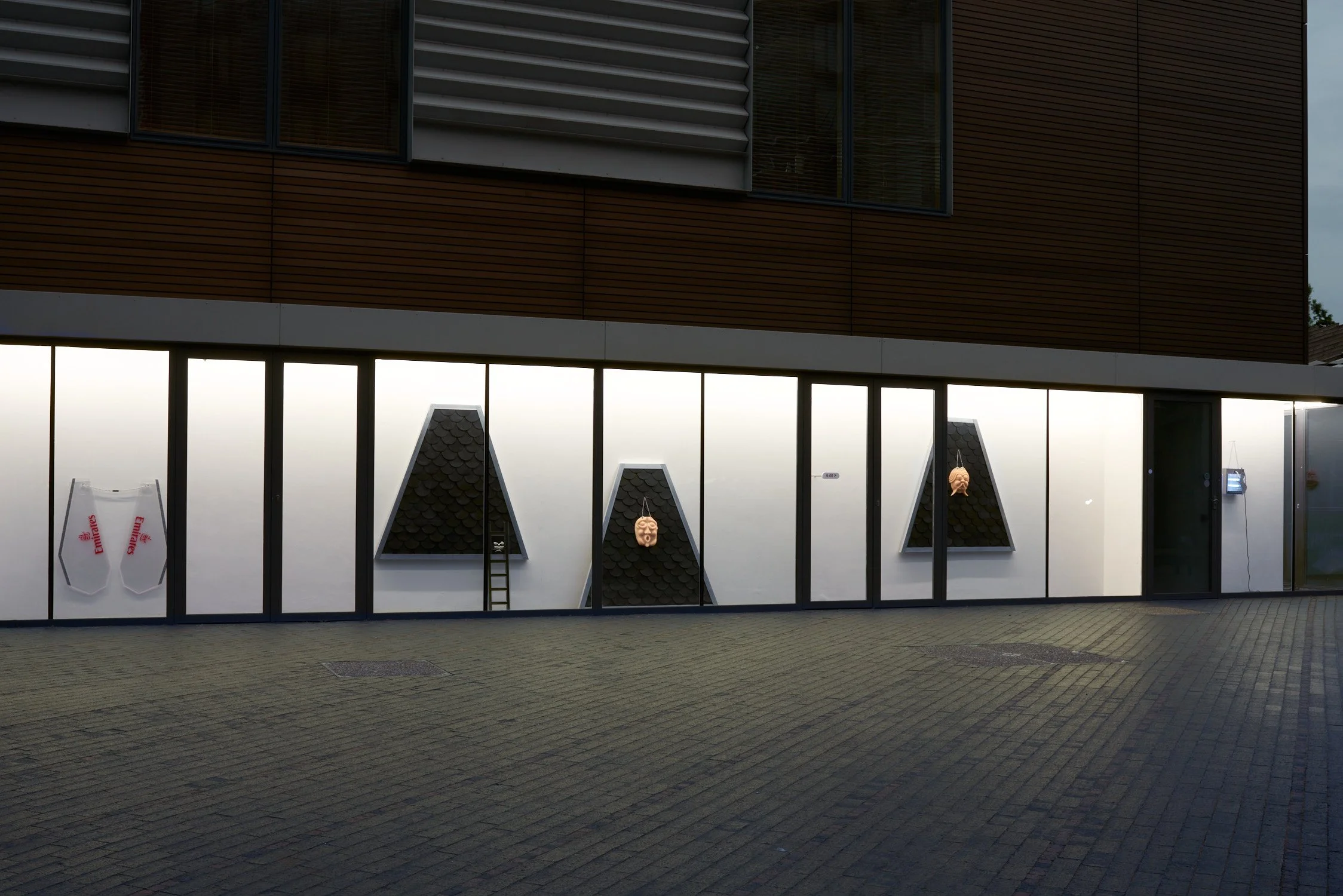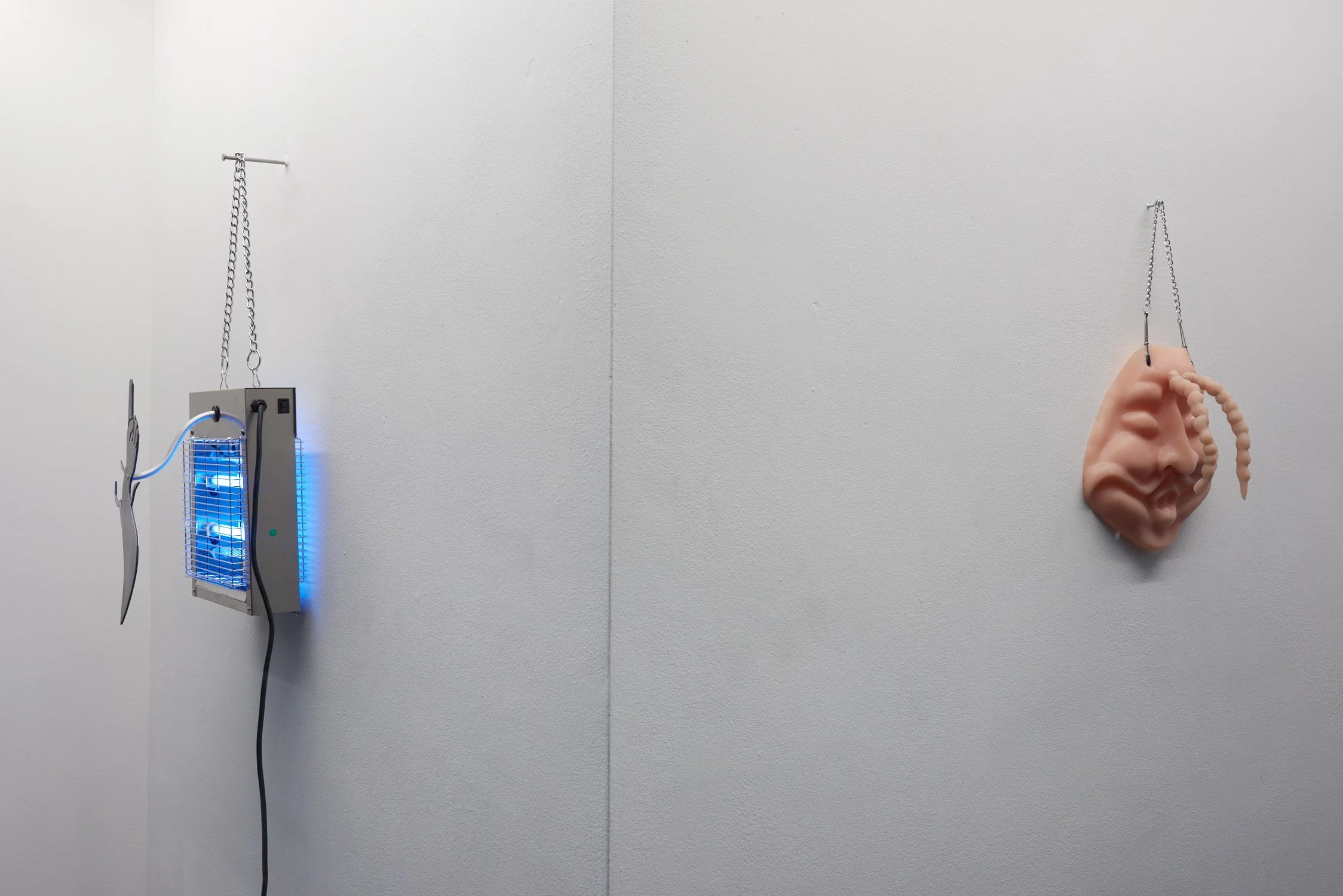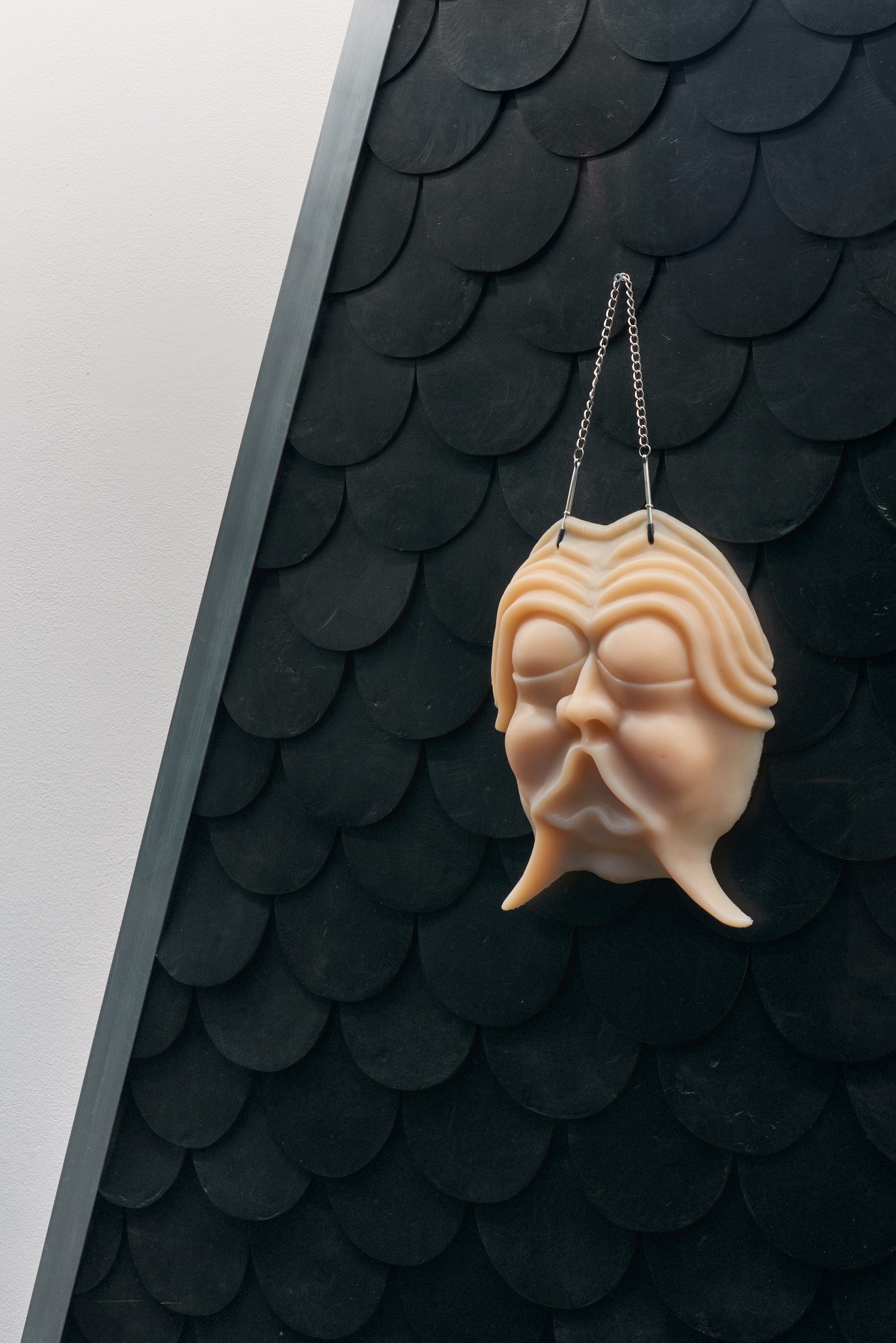Exhibition view from Romain Sarrot solo exhibition, '9:00 AM' with HATCH and hosted by VITRNE in London, 2022. Photo: Jonathan Bassett. Courtesy of the artist, Hatch Gallery and VITRINE.
Exhibition view from Romain Sarrot solo exhibition, '9:00 AM' with HATCH and hosted by VITRNE in London, 2022. Photo: Jonathan Bassett. Courtesy of the artist, Hatch Gallery and VITRINE.
9:00 am
Romain Sarrot
Curated by Anissa Touati
June 29 - September 10, 2023
15 Bermondsey Sq, London SE1 3UN, United Kingdom
Kindly hosted by VITRINE
9:00 AM is the 3rd chapter of Romain Sarrot’s “conceptual creativity cycle corpus”: the quater of Departure number I.
The installation questions the search for a mysterious kind of euphoria that accompanies the sensation of elevation. It puts us in this very particular state of weightlessness and suspension, as if our soul was leaving the body. For Romain Sarrot, the impossibility, for humans, to be satisfied with their finite condition is at the heart of the exhibition. He thus wants to represent the struggle between the desire for adventure and peace, between comfort and danger, the struggle between belief and experience.
The artist stages the porosity between heaven and earth, ascendent and descendent movements, the top and the bottom. The title-hour 9:00 AM brings together spiritual traditions. It evokes the “Third”, a prayer signifying both the descent and the ascent. The reference to 9:00 am is also present in popular culture, as in the song “Rocket Man” by Elton John. The song talks about an astronaut on a mission in space and whose family he misses. It is directly inspired by a science fiction short story by Ray Bardbury, “The Rocket Man”, told by Doug, a 14-year-old boy, whose father travels in space for three consecutive months, stays at home next to his grieving mother Lilly. In Bradbury's story, the rocket man is torn between his two lives as if was gravity pulling him back to the unknown adventure in the sky. Each time he returns, his wife experiences his living presence as a memory. The song highlights the feeling of fatality and loss on the part of the father. By means of a theatrical installation, 9:00 AM therefore deals with latency and with the feelings it engenders. Romain Sarrot stages the euphoria of losing ground and the exaltation of elevation by using an all-encompassing mystical white light, opacified window, fragments of roof-tops and ladders. The spectator is situated at the level of experience. He lives the experience as if he was omniscient.
One way of approaching the exhibition is to see how it explores forms of transcendence. Ascension is one of them. The spectator is moving beyond the limits of the physical world. We are entering into a spiritual realm, evoking the feeling of rising above the earth when one starts to fly. There are faces in silicon in the exhibition. They are inspired by the Mostasu: “talking statues” that served as an outlet for the frustrations and complaints of the people. The reference to this popular form of confession, coexisting with more traditional Christian confessions, introduces a more ambiguous take on transcendence and spirituality. The Mostasu is a hybrid sitting somewhere between the insect, the human and the animal. The use of silicon not only refers to human flesh but also to sexuality, as if we were looking at the repressed in religion.
Throughout the exhibition 9:00 AM, we are facing the profound dissatisfaction that lies underneath our mystical quests of euphoria. In John Steinbeck's "The Winter of Our Discontent", Ethan experiences the feeling of "Weltschmerz". This term, introduced by German romantic poet Jean Paul, refers to the pain one feels when one realizes that our spiritual desires will never be fulfilled because of the physical limitation of a finite world. One could say that it is this pain that the exhibition is trying to translate visually. It thus plunges us into melancholia when we realize that this world will never satisfy our deepest desires.
Courtesy of Anissa Touati
About Romain Sarrot:
Romain Sarrot (b. 1986, France) lives and works in Paris. His installations and sculptures question the notion of heritage. By exploring architectures, popular cultures, myths and legends that have shaped civilizations, Romain Sarrot seeks to transcend our modern environments. He introduces new relationships between objects and their nature, spaces and their representation, traditions and their projection. Through a vocabulary of forms, both human and animal, vegetal and industrial, Romain Sarrot's work is a syncretism of cultures, rituals, memories of our inner and outer world. His process and his creations are defined by staging, materials and dialectics specific to a cycle that he describes as "circular conceptual creativity". His production is articulated and paced in four chapters or quarters that begin with rebirth and life, and end with departure and death. Each chapter is structured by a constellation of imaginary hybrid objects that define space, temporality and the implied narrative. A precise protocol by which the artist claims to "personify or extrapolate forms of human consciousness". The vital impetus of Sarrot's work finds its source in the realization of scenographic experiences, as physically as intellectually immersive.
Sarrot was invited to participate in several exhibitions across European, and international, galleries and institutions. His first solo exhibition, I miss you office, co-curated by Chri Frautschi and Nicolas Raufaste, opened in 2021 at Lokal-int, Bienne (2021, CH). He was exhibited in the selected group shows namely: Infinite Looping in Harmony with HATCH, (2023, FR); Moonlight Mile, curated by M. LeBlanc gallery at Alan Koppel (2022, US); Songs die as soon as they are forgotten, curated by Anissa Touati at Artbeat Gallery (2022, GE); Palazzo Monti, curated by Edoardo Monti at Palazzo Monti, (2021, IT); Your Friends and Neighbors at High Art (2020, FR) and Zeige deine Wunde, curated by Klaus Speidel at Dom Museums (2018, AT). Sans Titre Gallery presented his work at international art fairs: Materials (2018, MX) and Paris International (2017, FR). In 2021, Sarrot was invited by Edoardo Monti to be a resident at Palazzo Monti. For his first solo presentation in London with HATCH, and in collaboration with VITRINE Gallery, Sarrot presents 9AM, curated by Anissa Touati.
Exhibition view from Romain Sarrot solo exhibition, '9:00 AM' with HATCH and hosted by VITRNE in London, 2022. Photo: Jonathan Bassett. Courtesy of the artist, Hatch Gallery and VITRINE.
Exhibition view from Romain Sarrot solo exhibition, '9:00 AM' with HATCH and hosted by VITRNE in London, 2022. Photo: Jonathan Bassett. Courtesy of the artist, Hatch Gallery and VITRINE.
Exhibition view from Romain Sarrot solo exhibition, '9:00 AM' with HATCH and hosted by VITRNE in London, 2022. Photo: Jonathan Bassett. Courtesy of the artist, Hatch Gallery and VITRINE.
Exhibition view from Romain Sarrot solo exhibition, '9:00 AM' with HATCH and hosted by VITRNE in London, 2022. Photo: Jonathan Bassett. Courtesy of the artist, Hatch Gallery and VITRINE.
Romain Sarrot, Toit (2) and Mostasu (2), details, 2022, Auto-curing putty, acrylic paint, varnish, aluminium, wood, silicon, nipple metal clamps, butterfly, 150 x 150 x 7 cm, Photo: Romain Sarrot. Courtesy of the artist, Hatch Gallery and VITRINE.
Exhibition view from Romain Sarrot solo exhibition, '9:00 AM' with HATCH and hosted by VITRNE in London, 2022. Photo: Jonathan Bassett. Courtesy of the artist, Hatch Gallery and VITRINE.
Romain Sarrot, Toit (1) and Jacob I, 2023, Auto-curing putty, acrylic paint, varnish, aluminium, wood, plastic, silver gilding, 150 x 150 x 7 cm. Photo_ Jonathan Bassett. Courtesy of the artist, Hatch Gallery and VITRINE.
Romain Sarrot, Air Con (Emirates), 2022, Altuglas, epoxy resin, aluminium, 40 x 100 x 2,5 cm. Photo_ Jonathan Bassett. Courtesy of the artist, Hatch Gallery and VITRINE.
Romain Sarrot, Mostasu (3), 2021, Silicon, nipple metal clamps, 26,5 x 25 x 10 cm. Photo_ Jonathan Bassett. Courtesy of the artist, Hatch Gallery and VITRINE.
Romain Sarrot, Easy Zap (hand), 2023, Dibond, aluminium rod, rubber, chain, insect remover, 28 x 35 x 30 cm. Photo: Jonathan Bassett. Courtesy of the artist, Hatch Gallery and VITRINE.
Romain Sarrot, Toit (3) and Mostasu (2), 2022, Altuglas, plastic and silver gilding, 150 x 150 x 7 cm. Photo_ Jonathan Bassett. Courtesy of the artist, Hatch Gallery and VITRINE.
Romain Sarrot, 9:00 AM, 2023, Altuglas, resin, epoxy, pigment, aluminium, 6,8 x 20 x 1 cm. Photo_ Jonathan Bassett. Courtesy of the artist, Hatch Gallery and VITRINE.














